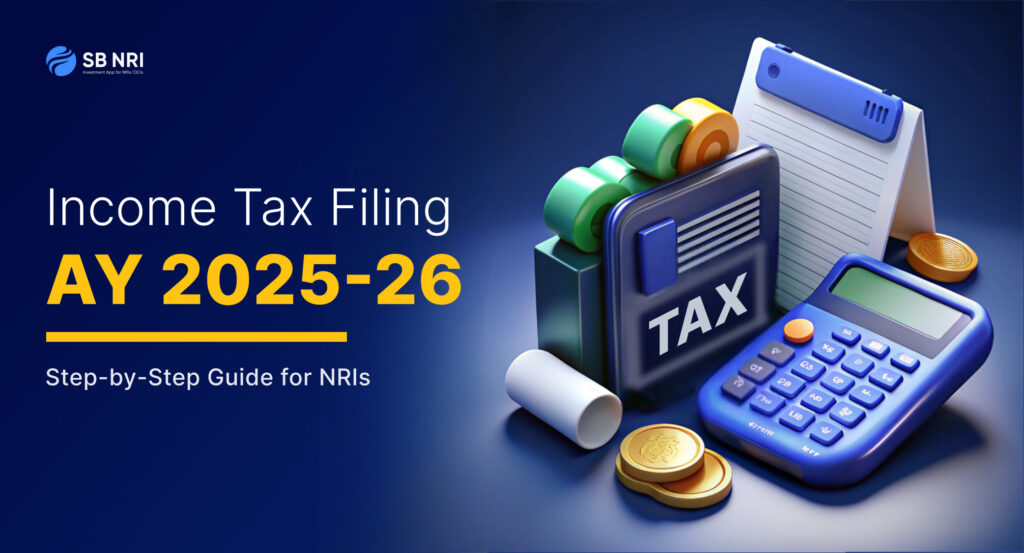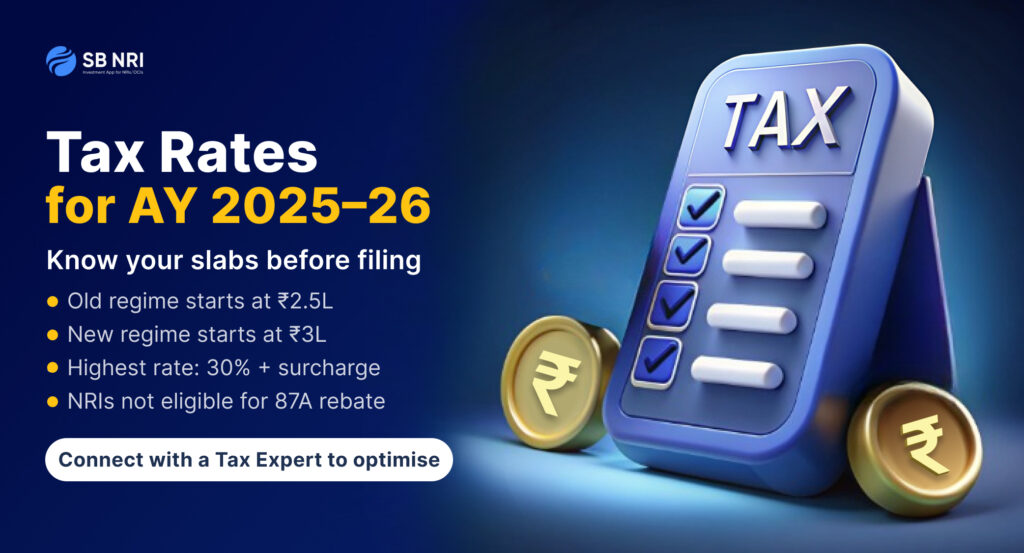
Filing ITR for NRIs (Non-Resident Indians) can feel overwhelming, especially with frequent updates to tax laws and residency rules. Whether you earn income in India from salary, rent, capital gains, or investments, understanding your tax obligations is crucial to avoid penalties and maximize your eligible deductions.
For Assessment Year (AY) 2025–26, NRIs need to pay special attention to residency thresholds, new tax regime rules, and reporting requirements.
This comprehensive, step-by-step guide will walk you through everything you need to know about income tax filing for NRIs – from confirming your residential status and choosing the right ITR form, to leveraging deductions and ensuring compliance with the latest regulations.
This guide covers important aspects like residential status, tax forms, deductions, tax regimes, and filing instructions for NRIs.
By the end, you’ll be equipped with actionable insights, practical examples, and expert tips to make your tax filing process smooth and stress-free.
Click on the button below to file your ITR in a hassle-free way.
Step 1: Confirm Your NRI Status for Indian Tax Purposes
Before you begin, it’s essential to determine if you’re a Non-Resident Indian (NRI) for tax purposes. This determines how your income will be taxed and whether you’re eligible for exemptions.
You are treated as a Resident in India for a financial year if you meet either of these conditions:
- You were in India for 182 days or more during the previous year
- You were in India for 60 days or more during the previous year and 365 days or more during the 4 years immediately before that year
You are considered a Non-Resident (NRI) if you do not satisfy both of the above conditions.

Important Exceptions for Indian Citizens and Persons of Indian Origin (PIOs):
- If you’re visiting India, the 60-day rule is replaced with 182 days
- If you’re leaving India for employment abroad or as a crew member, the 182-day condition applies
- From AY 2021–22, if your total Indian income (excluding foreign income) exceeds ₹15 lakh, the 60-day limit becomes 120 days
- If you meet certain criteria, such as being an NRI for 9 out of the last 10 years, or staying less than 729 days in India in the last 7 years, you may qualify as a Resident but Not Ordinarily Resident (RNOR). RNORs are taxed only on Indian income, not global income. Many NRIs overlook the RNOR status, which can be leveraged for tax planning during transition years when moving back to India.
- If your income exceeds ₹15 lakh and you’re not liable to pay tax in any other country, you may be classified as a Deemed Resident
Step 2: Determine Whether You Need to File ITR in India
ITR for NRIs should be filed in India if:
- You earned taxable income in India, such as salary, rent, capital gains, or interest
- You want to claim a TDS refund
- You want to carry forward losses
You are treated as a Deemed Resident under Indian tax law
Note: NRIs are not eligible for the rebate under Section 87A, even if total income is below ₹5 lakh.
ITR for NRIs: What’s Taxable & What’s Not
Indian vs. Global Income
As an NRI, only income earned or received in India is taxable. Global income is not taxed in India unless you become a resident or deemed resident. This includes salary received in India, rental income from Indian property, capital gains from Indian assets, and interest from Indian bank accounts.
Common Sources of Taxable Income for NRIs
- Salary for services rendered in India
- Rental income from property in India
- Capital gains from sale of Indian assets
- Interest from NRO accounts (taxable), but NRE and FCNR account interest is tax-free
- Dividends from Indian companies

Taxability of Investments, Property, and Salary
Interest on NRO accounts is taxed at 30% (plus surcharge and cess), while NRE and FCNR interest is exempt. Rental income is taxed after allowing standard deductions. Capital gains are taxed as per holding period and asset type.
Example:
If you sell a property in India, short-term capital gains are taxed at slab rates, while long-term gains attract 20% tax after indexation.
SB NRI Insight:
NRIs often miss out on double taxation relief by not claiming benefits under the Double Taxation Avoidance Agreement (DTAA) between India and their country of residence.
Do You Need to File an ITR? Filing Thresholds & Scenarios
Mandatory Filing Criteria
ITR for NRIs must be filed, if their total Indian income exceeds ₹2.5 lakh in a financial year, even if TDS has already been deducted. This threshold applies regardless of age.
Voluntary Filing & Benefits
Even if your income is below ₹2.5 lakh, filing a return can help claim TDS refunds, carry forward losses, and maintain financial records for visa or loan applications.
Special Cases (TDS Refunds, Carry Forward Losses)
If excess TDS has been deducted on your interest or capital gains, filing an ITR is the only way to claim a refund. Similarly, declaring losses allows you to offset them against future gains.
Unique Insight:
ITR filing can b skipped by some NRIs if their only income is from fixed deposits with TDS deducted. However, actual tax liability may be lower, and a refund is possible.
Step 3: Choose the Correct ITR Form
Depending on the source of your income, choose the appropriate return form:
- ITR-2: For individuals (Resident or NRI) and HUFs who do not have income from business or profession. Use ITR-2 if you have income from salary, property, capital gains, or other sources, but no business/professional income.
- ITR-3: For individuals and HUFs who do have income from business or profession
NRIs cannot use ITR-1 or ITR-4.
Step 4: Choose Between the Old and New Tax Regime
From AY 2025–26, the New Tax Regime under Section 115BAC is the default. However, you may opt for the Old Regime if it suits your financial situation better.
- Old Regime:
Allows deductions under various sections such as 80C, 80D, 24(b) - New Regime:
Offers lower tax rates but fewer deductions
You can still claim interest on housing loans for let-out property
Switching Rules:
- For non-business income, you can select the regime in the ITR form
- If you have business or professional income, and you want to opt out of the new regime, you must file Form 10-IEA before the ITR due date. You can switch back only once in your lifetime
Example:
If you have significant investments in PPF, NPS, or insurance, the Old Regime may offer more tax savings.
SB NRI Insight:
ITR for NRIs with fluctuating Indian income can be optimized by switching regimes based on deduction eligibility each year.
Step 5: Understand Applicable Tax Rates for NRIs

Here are the slab-wise tax rates for AY 2025–26:
Old Tax Regime
- Up to ₹2,50,000: Nil
- ₹2,50,001 – ₹5,00,000: 5%
- ₹5,00,001 – ₹10,00,000: ₹12,500 + 20% above ₹5,00,000
- ₹10,00,001 and above: ₹1,12,500 + 30% above ₹10,00,000
New Tax Regime (u/s 115BAC)
- Up to ₹3,00,000: Nil
- ₹3,00,001 – ₹6,00,000: 5%
- ₹6,00,001 – ₹9,00,000: 10%
- ₹9,00,001 – ₹12,00,000: 15%
- ₹12,00,001 – ₹15,00,000: 20%
- Above ₹15,00,000: 30%
Surcharge
- 10% if income exceeds ₹50 lakh but less than ₹1 crore
- 15% for income ₹1 crore to ₹2 crore
- 25% for ₹2 crore to ₹5 crore
- 37% for income above ₹5 crore
Note: The enhanced surcharge (25% or 37%) is not levied on certain types of income, such as long-term capital gains under sections 111A, 112, 112A, and dividend income. For such income, the maximum surcharge is capped at 15%
Health and Education Cess
- 4% on income tax plus surcharge
Marginal Relief
Marginal relief ensures tax does not exceed the incremental income over the threshold. It is applicable if total income slightly exceeds the surcharge thresholds.
Step 6: Collect All Necessary Documents
Keep the following ready to make your filing process smoother:
- PAN card, passport, and visa details
- Bank statements, property documents, and investment proofs
- Details of foreign assets (if applicable)
- Form 16: Certificate from employer for salary income and TDS
- Form 16A: TDS certificate on non-salary income (e.g., interest)
- Form 12BB: If claiming deductions like HRA, LTC, or housing loan interest
- Form 26AS: Summary of tax deducted/collected at source, advance tax, and self-assessment tax
- Annual Information Statement (AIS): Includes tax, financial transactions, refunds, SFT, and foreign asset details
- Form 10E: For claiming relief under Section 89(1) on arrears/advance salary
- Form 10BA: If claiming rent deduction under Section 80GG
- Form 3CB-3CD: Required if your accounts are audited under Section 44AB
- Form 3CEB: Required for international or specified domestic transactions under Section 92E
- Form 3CE: For reporting income under Section 44DA (e.g., technical fees from the Government or an Indian company)
Step 7: File Your ITR on the Income Tax Portal
Go to the official income tax website.
- Log in using your PAN and password
- Go to “File Income Tax Return”
- Select:
- Assessment Year: 2025–26
- Mode of filing: Online (Easier)
- ITR Form: ITR-2 or ITR-3
- Status: Individual
- Choose your tax regime (Old or New)
- Provide:
- Personal and contact information
- Residential status (choose Non-Resident)
- Income details from salary, rent, capital gains, interest, etc.
- Deductions, if applicable
- Bank account details for refund
Step 8: Verify Your Tax Credit
Before submitting, cross-check that:
- Income and TDS details match Form 26AS and AIS, as mismatches can delay refunds or trigger notices.
- Deductions are properly included under respective sections
- Advance tax or self-assessment tax payments are accounted for
If there are discrepancies in AIS, you can submit corrections through the AIS utility on the portal.
Step 9: Pay Self-Assessment Tax, If Required
If your total tax liability exceeds the TDS and advance tax paid, pay the balance using the e-Pay Tax portal.
Steps:
- Go to this Income tax portal
- Select Challan 280
- Choose “Self-Assessment Tax” and make the payment
Step 10: Review and Submit Your ITR
Once all details are correctly filled:
- Preview your return
- Validate information
- Click Submit
Step 11: e-Verify Your Return
After submission, verify your return within 30 days, or it will be treated as invalid.
Verification methods:
- Aadhaar OTP
- Net Banking
- Bank ATM
- Digital Signature Certificate (DSC, if applicable)
Step 12: Download and Save Your ITR-V Acknowledgement
Once e-verified, download the ITR-V (Acknowledgement) from your dashboard and keep it for your records.
Step 13: Know Your Eligible Deductions

Available in Both Regimes
- Standard deduction: Rs. 75,000
- Section 24(b): Interest on housing loan for let-out property (no upper limit)
- Section 80CCD(2): Employer’s contribution to NPS can be claimed (up to 14% of the basic salary)
Available in Old Regime Only
- Standard deduction for salaried individuals: Rs. 50,000
- Section 24(b): Interest on self-occupied property (up to ₹2 lakh)
- Section 80C, 80CCC, 80CCD(1): Investments like NRO fixed deposits, PPF, LIC, ELSS, tuition fees, etc. (combined limit ₹1.5 lakh)
- Section 80CCD(1B): Additional ₹50,000 for NPS
- Section 80D: Health insurance premiums (up to ₹25,000 or ₹50,000 for senior citizens)
- Section 80E: Interest on education loans
- Section 80EE / 80EEA: Interest on home loan for first-time buyers
- Section 80EEB: Interest on electric vehicle loan
- Section 80G: Donations to approved institutions
- Section 80GG: Rent paid, if not receiving HRA (with Form 10BA)
- Section 80GGA / 80GGC / 80JJA / 80JJAA / 80TTA: Other deductions for donations, employment, and savings interest
- Sections 80IA–80IE: Specific to businesses in infrastructure, SEZs, manufacturing, etc.
SB NRI Insight:
NRIs can claim an additional ₹50,000 deduction under Section 80CCD(1B) for NPS contributions, even if Section 80C limit is exhausted.
Common Mistakes & Compliance Tips for NRIs

Errors in Residential Status
Misreporting your residential status can lead to incorrect tax treatment and penalties.
Mismatches in AIS/Form 26AS
Always reconcile your reported income with Form 26AS and AIS to avoid notices and delays in refunds.
Missing Deadlines and Penalties
Late filing attracts penalties up to ₹5,000 and may restrict loss carry forward.
SB NRI Insight:
NRIs often forget to disclose foreign assets when transitioning to resident status, which can attract severe penalties under the Black Money Act.
Frequently Asked Questions (FAQs)
Q1. Can NRIs file their income tax return online from abroad?
Yes, ITR for NRIs can be filed online from anywhere using the income tax portal. E-verification can be done via Aadhaar OTP, net banking, or DSC.
Q2. Is income from NRE and FCNR accounts taxable for NRIs?
No, interest from NRE and FCNR accounts is tax-free for NRIs, but interest from NRO accounts is taxable at 30%.
Q3. What happens if I miss the ITR filing deadline as an NRI?
You can file a belated return with a late fee, but you may lose the benefit of carrying forward losses and face penalties.
Q4. How can NRIs claim a refund for excess TDS deducted?
By filing an ITR and declaring actual income, you can claim a refund for any excess TDS deducted on your Indian income.
Q5. Are NRIs eligible for the Section 87A rebate?
No, NRIs are not eligible for the Section 87A rebate, even if their total income is below ₹5 lakh.
Quick Takeaways
- Determine your residential status each year to ensure correct tax treatment.
- Only Indian income is taxable for NRIs; global income is taxed only if you become a resident or deemed resident.
- Choose the correct ITR form (ITR-2 or ITR-3) and tax regime based on your income sources and deductions.
- File your ITR online and verify it within 30 days to avoid invalidation.
- Claim all eligible deductions under the Old Regime to minimize tax liability.
- Double-check Form 26AS and AIS for discrepancies before submitting your return.
- Avoid common mistakes like misreporting residential status or missing deadlines.
Need Help? Reach Out
This guide is for informational purposes only. It is recommended to consult a qualified professional for case-specific guidance.

Conclusion
ITR for NRIs in AY 2025–26 doesn’t have to be daunting. By understanding your residential status, knowing what income is taxable, and leveraging available deductions, you can ensure compliance and optimize your tax outgo. With the new 120-day rule and changes in default tax regimes, staying updated is more important than ever.
Filing your return online, verifying details, and keeping thorough documentation will help you avoid penalties and make the most of your Indian income. If you’re unsure about any aspect, don’t hesitate to consult a qualified tax professional. Start early, stay organized, and take charge of your financial well-being – no matter where in the world you are.



